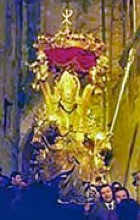


Gilded wooden statue (1753)
of St Emilianus enthroned
Two copies of the "Passio Sancti Miliani" (BHL 0107) survive:
-
✴a copy (9th century) in the Abbazzia di Montecassino; and
-
✴a copy (12th century) in the Leggendari del Duomo.
According to this legend, St Emilianus came from Armenia to Spoleto in the reign of the Emperor Maximian (286-305). They were aware that the Christians of nearby “Civitas Lucana” did not have a bishop so they recommended St Emilianus for the position. They duly arranged for an unknown pope to consecrate St Emilianus as their bishop.
St Emilianus was subsequently arrested and tortured in an attempt to force him to renounce his faith. Among the tortures that he survived:
-
✴he was thrown into a river called “Cleoton” with a stone to weigh him down, but emerged from the water;
-
✴he was thrown to wild animals, but the lions licked his face and the leopards lay at his feet;
-
✴he was summoned to the theatre and then taken to a high place where he was tied to a wheel, but the bonds released themselves and the wheel sped downhill, killing some of the onlookers.
He was finally tied to an olive tree at a place outside Civitas Lucana called Carpiani, where he was beheaded.
Scholars have identified:
-
✴Civitas Lucana as the ancient settlement below modern Trevi, near the church of Santa Maria di Pietrarossa;
-
✴the river Cleoton as the Clitumnus; and
-
✴Carpiani as nearby Bovara, the site of an ancient olive tree that is traditionally associated with the execution of St Emilianus.

Cult of St Emilianus
The original location of the relics of St Emilianus is unknown, although they may well have been preserved in Sant’ Emiliano. The Spoletans destroyed Trevi in 1214, and it seems likely that this provided the opportunity for them to seize the relics. They were certainly there before 1296, when St Emilianus was mentioned in the statutes of Spoleto alongside the other patron saints of that city.


Return to Saints of Trevi.

